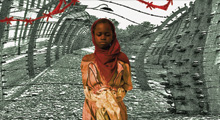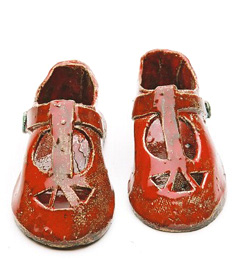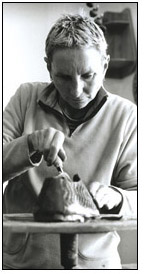 |
 |
Home
Shoes of Memory
| ||||||
|
I would like to speak briefly about how I came to make this work and about the creative process involved. I visited Auschwitz for the first time 5 years ago. I was profoundly affected by my experience there and afterwards felt compelled to translate it creatively. This, combined with the fact that my father survived Buchenwald and Dachau, made me realise that the time had eventually arrived for me to explore my legacy as the child of a survivor, what it meant to me and how it had affected my life.
Shoes can tell us so much about their owner. In so many of the accounts of survivors, there is invariably a story about shoes. They caused pain, infection, deaths, and occasionally, more happily, they saved lives. I was also very moved at this time by Anne Michaels' book, Fugitive Pieces, a particular phrase reverberating time and again when I was making them. I imagined if each owner of each pair of shoes could be named, then they would be brought back to life. I was clear that I didn't want to do a pile of shoes. I wanted to create something that honoured each individual. The narrative that I returned to time and time again was from Primo Levi's book, If this is a Man:
As a result of reading this passage, together with other research, I started to make odd pairs of worn shoes and boots of all sizes- men's, women's and children's. At this point I also started to research shoe styles of the period because I wanted my work to be completely authentic to that time in history. I also wanted them to be beautiful ceramic objects. I have often been asked how I have been able to create beauty out of the unspeakable. My answer is simply that I needed to pay homage to all those special and unique lives that were so painfully and senselessly lost. And I wanted to make work that had aesthetic qualities which would be remembered for its beauty, rather than something that was impactful in a shocking, bloody or horrific way.
In a review I read of an Art exhibition entitled The Atrocity Exhibition,
Producing this work has been an extraordinary and important journey. A journey which was often painful, certainly cathartic, and ultimately healing. I feel honoured that they are being shown at Purdue University. I am so sorry that I have been unable to be with you all at the opening. However, I do hope that my words have given you a sense of how this work was inspired and created. Thank you. Jenny Stolzenberg January, 2007 |
I imagined that if each pair of shoes could be named, they could be brought back to life. 
|
|
Artist website: Jenny Stolzenberg Ceramics | ||
Greater Lafayette Holocaust Remembrance Committee
2861 Linda Lane, West Lafayette, Indiana 47906
sue@glhrc.org
 I wrestled with choosing shoes for my work, but finally realised this is what I had to make. Shoes are so incredibly evocative. I imagine that probably everyone here today remembers their very first pair of shoes, their style, their colour, and the pride with which they wore them. Many of you will, I'm sure, have read Amos Oz, Tales of Love and Darkness, when he talks about his very first pair of shoes. He wrote:
I wrestled with choosing shoes for my work, but finally realised this is what I had to make. Shoes are so incredibly evocative. I imagine that probably everyone here today remembers their very first pair of shoes, their style, their colour, and the pride with which they wore them. Many of you will, I'm sure, have read Amos Oz, Tales of Love and Darkness, when he talks about his very first pair of shoes. He wrote: